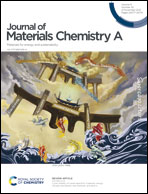Antimony doping to greatly enhance the electrocatalytic performance of Sr2Fe1.5Mo0.5O6−δ perovskite as a ceramic anode for solid oxide fuel cells†
Abstract
Perovskite oxide Sr2Fe1.5Mo0.5O6−δ (SFM) has attracted much attention as a potential ceramic anode material for solid oxide fuel cells. In this work, antimony is primarily proposed to partially replace the Mo element in order to improve its electrochemical performance. Sb doping significantly reduces oxygen vacancy formation energy and hybridization between Fe 3d and O 2p electrons, promotes the reduction process for anode application, greatly increases the oxygen vacancy concentration and the content of adsorbed oxygen species, and effectively improves the surface reaction rate constant for the hydrogen oxidation reaction and chemical oxygen diffusion coefficient. Consequently, Sb doping greatly improves the anode performance by a factor of 2.4 through decreasing the area specific interfacial polarization resistance from 0.184 to 0.075 Ω cm2 at 800 °C. The performance is much higher than those ever reported for SFM doped with various metal elements, and is even higher than those of SFM-based composite electrodes. In addition, Sb doping greatly improves fuel cell performance such as increasing the peak power density from 681 to 920 mW cm−2 at 800 °C with H2 as the fuel. Meanwhile, improvement is also achieved with syngas and ethanol fuels, generating peak power densities of 765 and 557 mW cm−2, respectively.

- This article is part of the themed collection: Journal of Materials Chemistry A HOT Papers


 Please wait while we load your content...
Please wait while we load your content...